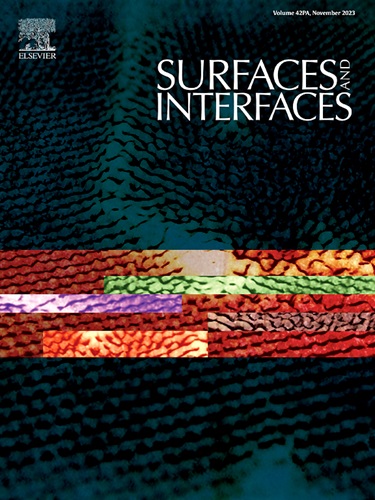Low-dielectric polyimide composite films with enhanced thermal, mechanical, and hydrophobic properties via silica aerogel integration
IF 5.7
2区 材料科学
Q2 CHEMISTRY, PHYSICAL
引用次数: 0
Abstract
This study investigates the morphological, thermal, dielectric, mechanical, and surface properties of polyimide/silica aerogel (PI/SA) composite films with varying SA content of 3–10 wt%. Nitrogen adsorption/desorption isotherm analyses confirmed the mesoporous structure of SA, exhibiting a high specific surface area (241.1 m²/g) and an average pore size of 34.9 nm. Electron microscopy and energy dispersive spectroscopy mapping revealed uniform dispersion of SA within the PI matrix. Thermogravimetric analysis indicated that PI/SA composites exhibited enhanced thermal stability, as evidenced by increased thermal decomposition temperature and residual char content at 800 °C with higher SA loading. Differential scanning calorimetry analysis demonstrated a slight increase in the glass transition temperature due to the restricted PI chain mobility by the uniform dispersion and interfacial interactions of SA with an intrinsically robust silicate framework. Dielectric property evaluations revealed a significant reduction in dielectric constant, from 3.02 (neat PI) to 2.16 (composite with 10 wt% SA), attributed to the introduction of nanoscale voids within the SA framework. The mechanical properties showed an increase in tensile strength and elastic modulus up to 7 wt% SA, followed by a decrease at 10 wt% due to partial filler agglomeration. Additionally, contact angle measurements indicated improved hydrophobicity with increasing SA content, suggesting enhanced moisture resistance. These findings demonstrate the potential of PI/SA composite films for advanced microelectronic and insulation applications requiring low dielectric properties, high thermal stability, and improved hydrophobicity.
低介电聚酰亚胺复合薄膜与增强热,机械和疏水性能通过硅胶气凝胶集成
本研究考察了不同SA含量(3-10 wt%)的聚酰亚胺/二氧化硅气凝胶(PI/SA)复合膜的形态、热、介电、力学和表面性能。氮吸附/脱附等温线分析证实了SA的介孔结构,具有较高的比表面积(241.1 m²/g),平均孔径为34.9 nm。电镜和能谱图显示SA在PI矩阵内均匀分散。热重分析表明,在800°C时,随着SA的增加,PI/SA复合材料的热分解温度和残余炭含量增加,表明其热稳定性增强。差示扫描量热分析表明,由于SA的均匀分散和与本质上坚固的硅酸盐框架的界面相互作用限制了PI链的迁移率,因此玻璃化转变温度略有升高。介电性能评估显示介电常数显著降低,从3.02(纯PI)降至2.16(含10 wt% SA的复合材料),这归因于在SA框架内引入纳米级空隙。力学性能表现为拉伸强度和弹性模量增加至7 wt% SA,随后由于部分填料团聚而降低至10 wt% SA。此外,接触角测量表明,随着SA含量的增加,疏水性得到改善,表明抗湿性增强。这些发现证明了PI/SA复合薄膜在需要低介电性能、高热稳定性和改进的疏水性的先进微电子和绝缘应用中的潜力。
本文章由计算机程序翻译,如有差异,请以英文原文为准。
求助全文
约1分钟内获得全文
求助全文
来源期刊

Surfaces and Interfaces
Chemistry-General Chemistry
CiteScore
8.50
自引率
6.50%
发文量
753
审稿时长
35 days
期刊介绍:
The aim of the journal is to provide a respectful outlet for ''sound science'' papers in all research areas on surfaces and interfaces. We define sound science papers as papers that describe new and well-executed research, but that do not necessarily provide brand new insights or are merely a description of research results.
Surfaces and Interfaces publishes research papers in all fields of surface science which may not always find the right home on first submission to our Elsevier sister journals (Applied Surface, Surface and Coatings Technology, Thin Solid Films)
 求助内容:
求助内容: 应助结果提醒方式:
应助结果提醒方式:


